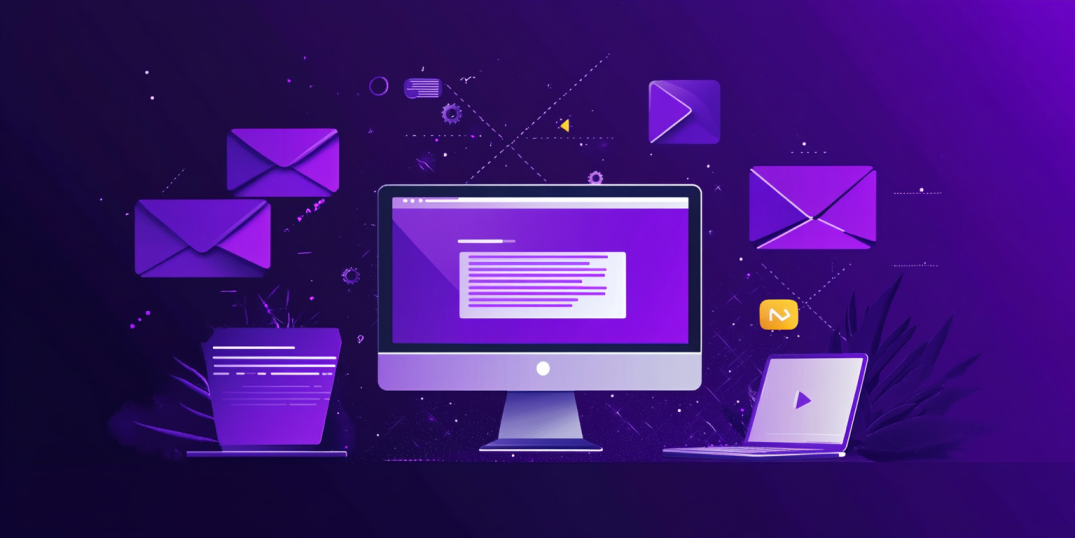- Home
- Email Tips and Tricks
- The Golden Rules of What Makes ...

Contemporary technology—artificial intelligence included—has brought us a lot of genuinely useful things. Smart tools that save us hours, algorithms that learn what we like, features that make work and life easier in ways we couldn’t have imagined even a decade ago. And yet, there’s another side we’re starting to feel more and more: the sense that everything is being filtered, flattened, and optimized.
Especially when it comes to communication. Be it B2B, B2C, or person-to-person—so much of it feels transactional. Like, ah yes, another friendly email that wants me to buy something. Maybe that’s why email newsletter marketing still matters.
Because there’s something oddly comforting about a newsletter that feels slightly chaotic but real. Someone talking about a weird cooking experiment. A new art app they just found. Summer plans. Travel tips. Coffee and croissants. Whatever it is—when the newsletter content feels human, it feels great! And that, honestly, is what makes a good newsletter—the feeling that someone wrote it with you in mind.
Get More Opens Without Sacrificing Your Soul
Rule #1: Make your subject lines intriguing
You know what doesn’t make someone open your newsletter? Subject lines like “August Newsletter.” Or “Weekly Update #7.” Or anything that sounds like it was typed by a careless bot. A good subject line sounds different… It intrigues you, making you feel like you have to open it. You don’t even know why—you just have to. That’s the vibe you’re going for. For example, “Okay, don’t freak out, but…”—if you start like this, you are teasing the beginning of a story. So, say something a little unexpected. Be a little weird. Dangle an idea. Don’t give everything away. That’s a recipe that makes readers naturally want more.
Rule #2: Don’t underestimate the value of your preheader
Not a single part of your email shall be ignored or seen as irrelevant. And too many brands treat the preheader exactly like this. Instead, it should be seen as your mini-movie trailer—because it’s the second thing people see after the subject line. It’s a free opportunity to build curiosity, tease the vibe, and nudge the open. So don’t miss it.
Rule #3: Pick a sender name that people want to talk to
The sender name is your absolute first impression. And if your email comes from a no-reply@brandname.com, you’ve already made a bad one. One of the most overlooked newsletter tips is to be someone people actually want to hear from. And no-reply is not that person—if it’s a person at all. Sam from Corner Coffee, on the other hand, feels completely opposite. It feels warm and real, like it came from someone who wrote this just for you. And the biggest—probably the biggest—advantage of this? It’s such a small adjustment, but it does way more than you think.
Rule #4: Segment
This one probably shouldn’t even need explaining—because no contemporary, successful email newsletter marketing campaign should exist without segmentation. Every marketer should know by now: you can’t send the same newsletter content to everyone. So once again—group your audience by interest, behavior, and vibe. Then talk to them like you know what they care about.
Rule #5: Great newsletters are no strangers to A/B testing
While we all hope for perfection on the first try, with email newsletter marketing, that’s rarely the case. And the winners are the ones who test. And the prize here is real clarity: you don’t have to guess or hope—you can know. A/B testing leads to effective newsletters that get smarter with every send. So yes, test. Then test again. And then test something weird. People might actually like it. Sometimes the wrong version wins.
Rule #6: Be a good email neighbor
What definitely doesn’t make a great newsletter is getting flagged as spam. And when you send emails too often, ignore unsubscribes, or pack your message with strange links, email clients get frustrated. And when they do, they blacklist your domain. That means even the best subject line, the smartest segmentation, the strongest newsletter content—none of it will matter, because no one will see it.

Design Like You Actually Care
Rule #7: Create a clear visual flow
Emails are not essays. They do not enjoy the luxury of build-up or slow-burn storytelling. Instead, newsletter content must unfold visually—in layers and with structure. A strong headline creates the initial anchor. Subheadings serve as stepping stones. Short, clear paragraphs act like information units. This is the way you adapt content to the way modern brains read: fast, nonlinear, and always ready to swipe away.
Rule #8: Make it mobile-friendly
It is no longer a niche case—mobile reading is the default mode. And yet, many campaigns continue to ignore this, relying on desktop designs that implode the moment they’re opened on a phone. Tiny buttons, overlapping text, distorted images—all signal a lack of care. In effective newsletters, design adapts to context. It recognizes where it will be consumed and responds accordingly.
Rule #9: Whitespace does not equal wasted space
Among amateur designers, there exists a fear of empty space—a compulsion to fill every inch of an email with something. But whitespace provides structure and allows content to speak. The best newsletter tips often come down to restraint and, ironically, by doing less, you can sometimes achieve more.
Rule #10: Start strong (Inverted pyramid style)
In journalism, the inverted pyramid model exists for a reason: front-load the important stuff. Readers drop off fast—especially in digital formats—so give them value before they have a chance to go. The same principle applies to email newsletter marketing. Do not wait until paragraph four to reveal the news, the offer, the event, the announcement. Start with it. Then elaborate. And only then, if they’re still with you, enrich.
Rule #11: Don’t be afraid of multiple CTAs
There is a certain paranoia in marketing around the single CTA rule—a fear that more than one button will somehow confuse the reader. But people are not as fragile as marketers think. You can include multiple calls to action if they make sense, meaning they should serve the same overarching purpose and not contradict each other visually. A well-designed newsletter can carry two or three CTAs, while confusion comes not from how many options exist, but from how they’re presented.

Make It a Joy to Read (And Easy to Escape If Needed)
Rule #12: Personalize but just a bit
While personalization is often cited as a cornerstone of effective newsletters, the form it takes is increasingly important. Excessive personalization (including birth dates or location callouts) can easily cross the line from thoughtful to intrusive. In contrast, minimal personalization, such as greeting a reader by their first name, combined with behavioral data, has been shown to increase engagement without compromising user comfort.
Rule #13: Send it when people are awake
Timing in email delivery plays a role similar to that of prime time in broadcast media. Despite the wealth of available data, many campaigns still send newsletters at arbitrary times, missing peak hours of engagement. The reality is that sending an email when the user is asleep, commuting, or already overwhelmed with notifications reduces the chances of visibility and immediate interaction. Research suggests that newsletter content sent in the late morning or early afternoon tends to perform best.
Rule #14: Keep it snappy
The cognitive effort required to read long-form emails is something most users are not ready to make. As studies on media consumption patterns show, brevity combined with structural clarity significantly improves user retention. So, what makes a great newsletter is making it consumable in under a minute and structured for skimming.
Rule #15: Allow people to unsubscribe easily
Email campaigns that make it difficult to unsubscribe often underestimate the long-term effects of negative user experience. Requiring users to log in, explain their reasoning, or click through multiple steps not only erodes trust, but increases the likelihood of being marked as spam—an action with far-reaching deliverability consequences. A single, clear click—ideally visible in the footer—is a must for contemporary email newsletter marketing.
Rule #16: Include a friendly footer
Often regarded as a mere compliance zone, the footer is, in fact, one of the last opportunities to communicate. While its primary purpose is to include legal disclaimers and contact information, the footer can also function as a subtle branding space. Social media links, or a brief sign-off, can maintain a connection after the body of the email is done.

Rule #17: Write Stuff People Actually Want
It’s often (and wrongly) assumed that email newsletter marketing is about selling, while in reality, the most effective newsletters are about very different things. The good ones help, entertain, or, if the stars align, they even inspire. It’s easy to underestimate how rare this is, especially in inboxes that have grown cynical from years of hollow promotions. Yet the data tends to agree: the newsletters people open, read, and forward are the ones that feel less like a campaign and more like a conversation.
A big part of this boils down to voice. Readers can smell corporate language from the subject line alone. And when your newsletter content does not sound genuine enough, it loses its power. This does not mean that newsletters should be careless—on the contrary, writing with personality often requires more thought, not less. But more thought in this case equals more emotion rather than formality.
The power of the right voice is that it can carry practically everything—even a story about your dog failing miserably at yoga. It doesn’t matter if the story is small or ridiculous. It matters that it feels original. Narrative, even in its lightest form, remains one of the most powerful tools in digital communication.
Another sign of a good newsletter is a mix-and-match approach. They mix their own thoughts with other people’s—linking to articles, quoting smart sources, highlighting tools, memes, insights. In this way, they become a kind of ongoing dialogue between the sender and the reader, where each issue provides something new, something useful, or oddly delightful.
Finally, what makes a good newsletter is knowing when to stop, even with good things. Too many text blocks or thoughts, and even the most valuable ideas lose their value. Besides, truly valuable things are always a bit scarce, which makes readers look forward to your next issue.
Sendigram Newsletter Collection (Free HTML Templates)
Creating a great newsletter is now easier with pre-designed email templates, like the ones offered by Sendigram. When you have something cool and genuine you want to share with your audience, you don’t need to start with a blank screen. Now it’s just about selecting a template that feels right and putting your story out there.

To Sum Up
If you’re wondering how to make a good newsletter, this article walks you through all the essentials—from crafting intriguing subject lines, to running A/B tests, to making sure your design actually works on mobile, and yes, to writing newsletter content that people genuinely want to read. That’s already a lot to consider! But one thing is worth repeating: no matter how many tips for newsletters you follow, the heart of it should still be the same—a real desire to bring value, to be honest, and to connect in a human way. While tools can help you design, automate, and optimize, the true motivation—the wish to spark curiosity, to share something good, to make your subscribers smile—that part can only come from you.



